Ecology and Management of Sericea Lespedeza
Sericea lespedeza (Lespedeza cuneata) (Figure 1) is an introduced perennial legume. It is relatively free of insect and disease problems, very competitive with other vegetation, and capable of thriving in a variety of environmental conditions, which are among the reasons it has become an invasive and noxious weed in Oklahoma. Sericea was promoted in the past to control soil erosion and provide forage for livestock and wildlife. It has been planted by both federal and state agencies on flood control dams, channelization projects, rights-of-way on highways, county roads, and private roads. From these plantings, sericea has been spread by animals and hay into native prairies, shrublands, forests, and introduced pastures. Reliance on single management practices such as grazing, burning, or spraying herbicides does not control sericea lespedeza adequately. However, initial reports indicate that integration of burning, grazing, and applying appropriate herbicides can help manage sericea and ultimately benefit the health of native plant communities, introduced pastures, cattle production, wildlife habitat, and biological diversity.
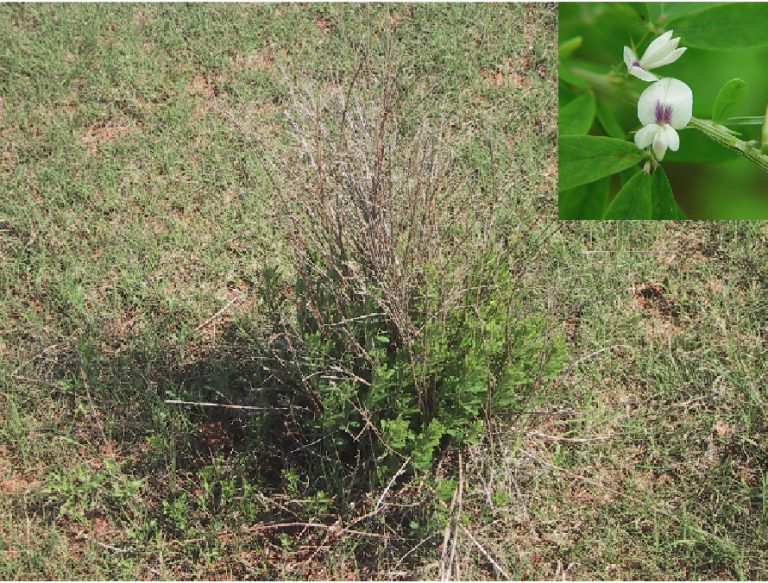
Figure 1. Sericea lespedeza in vegetative growth showing persistent stems from previous years’ growth and in the flowering stage (inset). Picture on right from USDA Plants website.
Sericea lespedeza has been found growing in all parts of Oklahoma except the Panhandle, and has been designated a noxious weed in Kansas because of its ability to invade and decrease grass production on rangelands and introduced pastures. In addition, it has had negative impacts on forage production for livestock, food, and cover for wildlife, and biological diversity.
Mature sericea plants are 18 to 40 inches tall with coarse stems and leaves composed
of three spatula-shaped leaflets with squared-off ends (Figure 2). Sericea often is
confused with desirable native legumes, especially slender lespedeza (Lespedeza virginica),
which looks very similar. Note the tips of slender lespedeza leaflets are more rounded
and do not have a conspicuous point at the end of the leaf (Figure 3). Pure stands
of sericea may produce 430 to 850 pounds of seed per acre per year with about 350,000
seeds in each pound. Seedlings are not very competitive, but once established, are
long-lived.
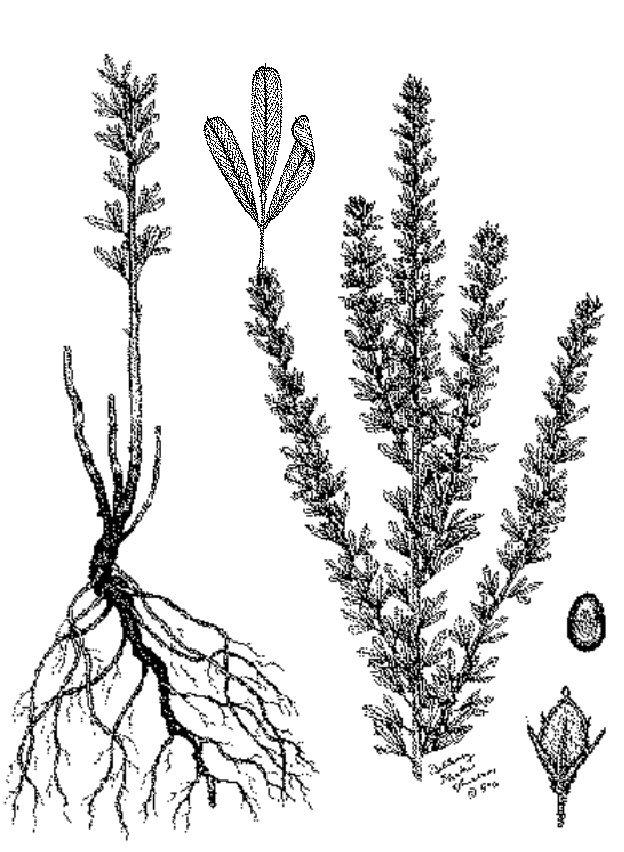
Figure 2. Sericea lespedeza.
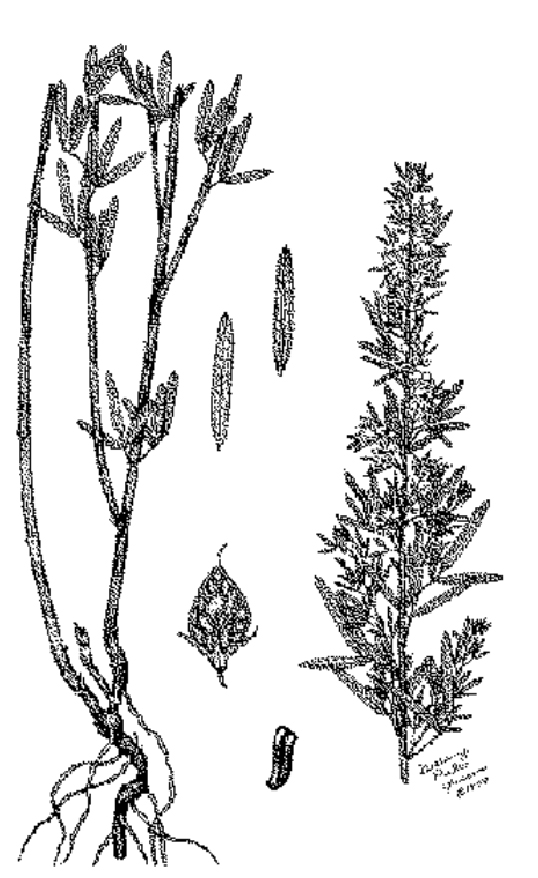
Figure 3. Slender lespedeza.
Sericea will tolerate soils ranging from very acidic to slightly alkaline, but prefers a pH of 6.0 to 6.5. It does best on clay and loamy soils that are deep, fertile, and well-drained, but will also grow on less productive soils. Sericea uses water less efficiently than many other warm-season plants and does best when annual precipitation is 30 inches or more, which explains why it is a greater problem in eastern Oklahoma. However, sericea occurrence has been reported on Conservation Reserve Program (CRP) lands and rangelands in western Oklahoma.
History in the United States
Sericea lespedeza was first brought to the United States from eastern Asia in the 1890s. Agronomists soon learned it was tolerant of drought, and shallow, acidic, low fertile soils. Because of this, sericea first was used as a protective cover for sites with unproductive soils. Two varieties of sericea were improved for quality characteristics and nematode resistance. These varieties were used on strip mines, highway right-of-ways, dams, and waterways. Sericea was also promoted for use in wildlife food plots, forage, hay, and land reclamation.
Competitive Effects
Sericea lespedeza can quickly change a landscape by out-competing more desirable vegetation. Sericea restricts the amount of light other plants can use because it is tall and produces multiple branches with dense foliage. Because of inefficient water use, sericea uses more water than most warm-season plants to produce a pound of biomass. In addition to competing for light, water, and nutrients, sericea produces allelopathic compounds (toxic chemicals that negatively impact the germination and/or growth of other plants). Some of these toxins are produced by the roots, while others come from plant residues, mainly leaves. Root extracts from sericea have been shown to reduce germination of bermudagrass by 9 percent and forage production of bahiagrass, bermudagrass, rye, ryegrass, and tall fescue by 15, 24, 7, 11 and 15 percent, respectively. The influence of these chemicals on the germination and growth of forage species in a natural system is difficult to measure and not well understood.
Sericea is a legume, but furnishes very little nitrogen to surrounding plants and
actually makes it necessary to add nitrogen fertilizer to maintain productivity of
introduced forages. The shoots of grass exposed to the toxins of sericea residue have
lower nitrogen content and overcoming the loss of production caused by the toxins
requires nitrogen fertilization.
Much of the research on the competitiveness of sericea lespedeza has been conducted
with introduced forages in greenhouses. Research in these controlled environments
focuses on individual factors of competition, while the combined negative effects
on native plants in uncontrolled environments of native prairies and forests are probably
much greater.
Forage for Livestock
Sericea lespedeza has high levels of crude protein, but is undesirable forage for cattle because of its high concentrations of tannins. Tannins bind proteins, leaving them unavailable for digestion. They also reduce the palatability and digestibility of forages. The level of tannins in sericea increases with plant maturity, high air temperatures, and low rainfall. New varieties of sericea have been developed with lower tannin concentrations, but tannin levels of these varieties are still too high and their forage production is 15 percent lower than that of high tannin varieties.
Wildlife and Plant Community Diversity
Wildlife species are adapted to the native plants of an area and are much better served by them for food and cover than most introduced plants. Sericea lespedeza has been promoted for use in food plots and for cover. Although some wildlife eat sericea foliage or seed, its greatest benefit to wildlife is its ability to provide thermal cover during the summer. However, sericea’s negative attributes overwhelm its few benefits. White-tailed deer will utilize sericea in early growth stages and during drought. Quail occasionally consume the seeds, but the seed are very low in nutritional value for quail. Although summer cover from sericea can be beneficial to quail, when sericea is dormant its beneficial cover qualities are eliminated. The exclusion of other plant species by sericea also reduces the diversity of plant foods needed to support a variety of wildlife.
Control Options
Once sericea is established, an integrated approach will be necessary for its control because there is no easy answer. Conventional practices such as grazing management and prescribed fire have not been effective in preventing the spread of sericea in rangelands (prairies and shrublands), introduced pastures, and forests.
It is difficult to give grasses a competitive edge with season-long or rotational
grazing with fences because cattle will select grasses and forbs and leave sericea
plants. This results in the over-utilizes grasses and forbs and allows sericea to
increase. Suppression of sericea has been observed when mowing or burning is followed
by intensive early stocking (IES) with stocker cattle.
Late-season grazing of sericea after seed-set mayonly spread the weed. Livestock,
especially mature cows, will consume the sericea seeds and flowers in the fall and
deposit them elsewhere in manure. It is advisable to exclude livestock from areas
with sericea until frost. Goats provide some control but also consume desirable native
plants that may be needed for cattle or wildlife use.
Prescribed Fire
Spring burning removes the old dead growth of sericea, but has no negative effect on established sericea. Summer fires have shown some increased sericea control over spring fires. Fire in any season can increase seed germination by scarifying (cracking the seed coat) the seed, thus promoting the establishment of new plants. Fire may also reduce the germination of sericea if the seed are exposed to high enough temperatures brought on by a high fuel load. Seeds of sericea germinate in early April through June, and seedlings become established if moisture conditions are favorable. Prescribed fire during this germination time will help in the removal of last years dead sericea, increase seed germination, may kill some sericea seedlings, and thus may improve the effectiveness of herbicides. But if the burn is poorly timed or implemented without other control measures, spring burning will likely result in denser stands of sericea.
Mechanical
Mowing will reduce the vigor of sericea plants if they are cut closely multiple times each year. Plants should be mowed each time they reach a height of 12 to 18 inches. The most damaging time to cut sericea is late in the growing season when the plants are trying to build root reserves for the next year’s growth. However, mowing will not kill sericea and may damage desirable grasses, depending on the timing and frequency of cutting. In addition, a large sericea seed bank will remain in the soil, ready to germinate when conditions are suitable.
Herbicides
The herbicides commonly used for broadleaf weed control have not provided good control of sericea lespedeza. Amber, 2,4-D, Grazon® P+D, and Weedmaster® have been ineffective on established stands of sericea. In studies conducted at three locations in 1988 and 1989, sericea was not controlled by 2,4-D at rates up to 2 lb/acre and minimal kill was achieved with 1 qt/acre of Grazon® P+D or Weedmaster®. Sericea was, however, adequately controlled with 1 pt/acre of Remedy (better than 93 percent in five of the studies and 79 percent in the sixth study). In other studies, excellent control of sericea was obtained with 1 pt/acre of Remedy® or 1.5 pt/acre Pasturegard® applied in June or early July when soil moisture was adequate for plant growth. Another valid herbicide control option includes 0.5 oz/acre Cimarron® applied in September during mid-bloom of sericea. For low infestations of sericea, rate 1 or 2 of Cimarron Max® can be applied in May or early June for its suppression. This application will control other broadleaf weeds well, suppress sericea to promote grass growth, but will not likely kill mature, well-established sericea plants as well as Remedy® or Pasturegard®. It is critical the sericea plants be actively growing at the time of herbicide application or the treatment will not be effective.
Since areas infested with sericea often have an enormous supply of seed in the soil,
follow-up treatments will be required. Seedlings emerge after the mature plants are
killed and by the third or fourth year, sericea could dominate the area again. Applying
rate 1 of Cimarron Max® in May or early June is a good control practice for targeting
young sericea as well as other broadleaf weeds present.
Using fire to encourage seed germination before spraying may be helpful in diminishing
the seed supply in the soil, thus reducing the amount of follow-up treatment needed.
In addition, preliminary results indicate removing sericea’s growth from the previous
year (through mowing or burning) may increase herbicide activity on mature sericea,
by allowing better spray coverage. For this practice to be successful, sufficient
time for regrowth of the sericea the year prior to application must be allotted.
A New Management Option in Native Plant Communities for Sericea Lespedeza Suppression
Recent studies have evaluated the effects of burning patches within a pasture and allowing cattle (stocked at a moderate to light stocking rate) free access to the entire pasture. This is an alternative to all forms of traditional grazing management including systems with or without fences or periods of rest (e.g. intensive early stocking, season-long stocking, management intensive grazing, short duration grazing, etc.). The Patch Burn system mimics historical fire and grazing patterns, maximizes structural and compositional biological diversity, and slows the spread of sericea. The Patch Burn system can be applied to any native vegetation type in prairies, shrublands, and forests.
Patch burning improves forage utilization and grazing distribution over time. Burning
patches within a pasture encourages cattle and all other herbivores to seek out the
newest plant growth which occurs in the most recently burned areas thus maximizing
forage quality. Research has shown that stocker cattle spend about 70 percent of their
grazing time in the most recently burned patch. With this increased grazing pressure,
the entire patch remains heavily grazed throughout the growing season, allowing plants,
including sericea, to provide continuous high nutrient quality forage. Cattle gains
are similar to traditional management but patch burning adds the advantage of rest
for a different portion of the pasture each year. Patch burning is not a one year
option and a manager must commit for multiple years to allow the cycle of heavy disturbance
followed by rest to proceed over the entire pasture unit.
This intensive season-long grazing following the patch burn has dramatic, but short-lived
effects on plant species dominance and vertical structure. During the year following
a patch burn in tallgrass prairie, litter accumulation is low, and forb cover is temporarily
increased due to the abundant bare ground immediately following the disturbance. By
the second growing season in a patch burn system, grasses begin to regain dominance,
while forbs are present to a lesser extent. Litter accumulation results due to decreased
grazing pressure and time since fire. In the third season following a patch burn on
tallgrass prairie, grasses become the dominant vegetative component, while forbs make
up a small minority because litter accumulation decreases available bare ground for
forb establishment.
The Patch Burning Experiment
Recent research at the Oklahoma State University Range Research Station west of Stillwater also has been conducted to assess the use of the Patch Burning System and moderate season long cattle grazing to manage Oklahoma rangelands. The Patch Burning System provides many benefits to landowners including increased diversity for quail, white-tailed deer, wild turkey, and other wildlife habitat. The Patch Burning System also has been evaluated for suppression of invasive by plants like sericea lespedeza. This study compared patch burning to the traditional rangeland management of season-long moderate stocking with cattle and prescribed burning the entire pasture periodically for eastern red cedar control. Differences between the burn timing and expanse of prescribed burns in the two treatments can be seen in Figure 4.
Results of the Experiment
Sericea Lespedeza Invasion Rates with Traditional Management vs. Patch-Burning System
At the initiation of the study, sericea lespedeza invasion was not significantly different between the treatments (see Figure 5). By the second year of the study period, the difference in sericea lespedeza cover became significant between treatments. The sericea lespedeza invasion rate was four times greater over time in the traditionally managed treatment compared to the Patch Burning System (1.9 and 0.5 percent per year, respectively). Sericea lespedeza establishment and persistence increased every year of the study in the traditionally managed pastures. In most cases, any one of the dominant functional groups in the tallgrass prairie can comprise up to 15 to 30 percent of the vegetative composition. The fact that sericea cover increased to nearly 17 percent by the end of the study indicates the shift in dominance on some of the traditionally managed areas. With the Patch Burning System, however, sericea lespedeza invasion was inconsistent, with fluctuations attributable to the effect of burning followed by periods of intense grazing to limit invasion or expansion. Even after the spring of 2003, when both treatments had the same amount of fire across the pasture, the invasion dynamics of the traditional treatment were linear; while the Patch Burning System exhibited slower expansion of sericea vegetative cover over time (see Figures 4 and 5).
Figure 4. The prescribed burn schedules for pastures in the a) Patch Burning System and b) traditionally managed treatments. By the spring of 2003, both treatments had the same amount of fire across the entire pasture. However, the Patch Burning System had patches in various states of recovery from fire at that time, while the entire pasture was recently burned in the traditionally managed treatment pastures. Grazing distribution and intensity differ greatly between the two treatments.
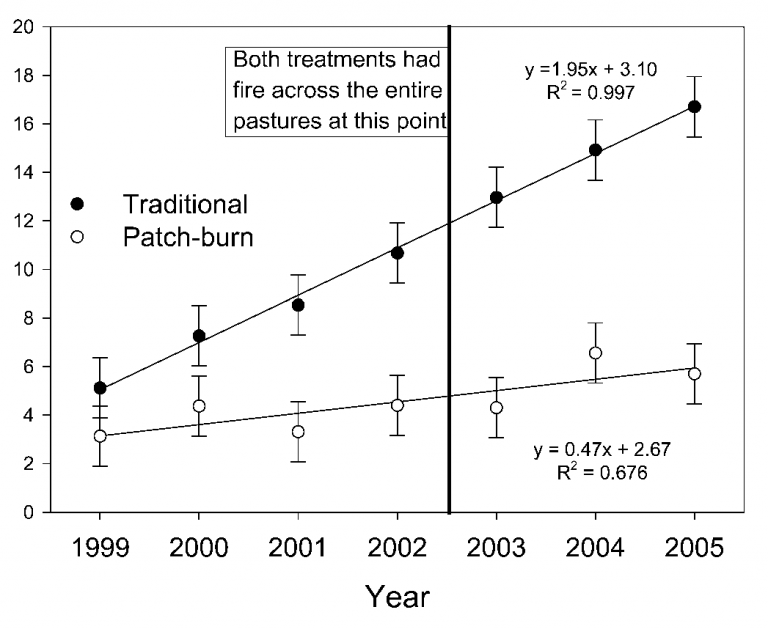
Figure 5. Sericea lespedeza invasion over time in the traditional management and Patch Burning System. In 1999, the treatments had similar levels of invasion. By 2000, the sericea invasion in the traditional management treatment was greater than in the Patch Burning System. In the spring of 2003, the traditional treatment pastures were burned in entirety, so both treatments had the same amount of fire over the pasture. After this point, invasion in the traditional management treatment followed the same linear increase of 2 percent per year, while the Patch Burning System displayed fluctuating invasions, decreasing in cover from 2002 to 2003, and increasing from 2003 to 2005.
Effect of Burn Season on Sericea Lespedeza Invasion
Within the Patch Burning System, sericea invasion rate was also affected by the season of prescribed burn (Figure 6). One and two years following prescribed fire, there was no difference in sericea lespedeza invasion between spring and summer burns. By the third year following prescribed fire, sericea lespedeza invasion in the spring burns increased significantly compared to summer burns. The data indicated that there may be advantages to burning during the late summer or early fall for sericea lespedeza suppression. Prescribed burning small patches in the same pasture over multiple seasons also offers available high quality forage base year round as new growth occurs following the burn.
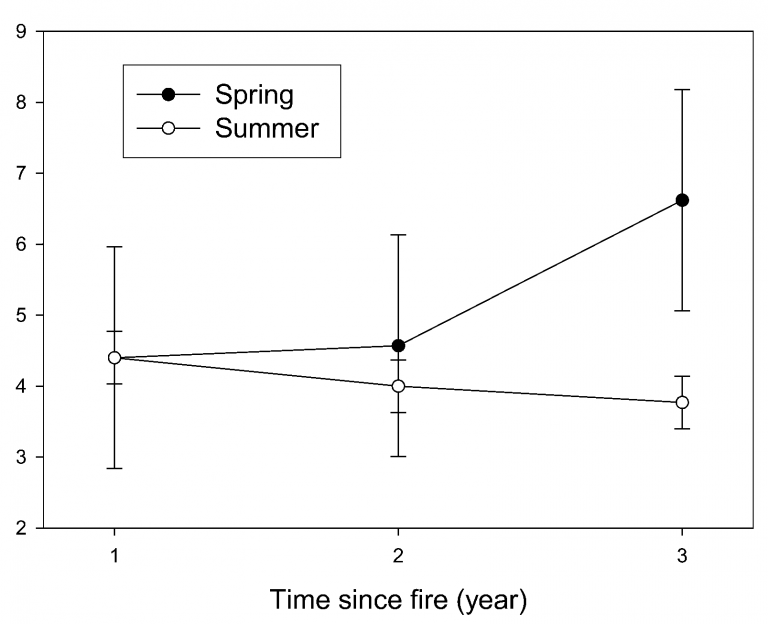
Figure 6. Sericea lespedeza invasion (as measured by increased vegetative cover) by time since fire in the Patch Burning System for spring and summer prescribed burns. For the first two years following fire, sericea cover was similar in both seasons of burn. At three years after the fire, summer fires had less sericea cover than spring fires. In addition the upward trend in cover with spring burns is sharply contrasted by the decreasing trend with summer burns.
Effects on Sericea Lespedeza Invasion on the Native Plant Community
Sericea lespedeza invasion also had a pronounced effect on the native plant community.
Most other different plants in the community (or functional groups) showed negative
correlations to sericea lespedeza invasion over time for both treatments (see Table
1). This was particularly noticeable in the traditionally managed treatment, where
sericea lespedeza invasion was more severe. The correlations were weak because of
the number of samples taken, but this could also mean the native plant community was
not as affected by sericea invasion until very severe levels of invasion are achieved.
Negative correlations in vegetative cover indicate the competition of native plants
with sericea lespedeza as a result of the invasion. The competitive advantage of sericea
lespedeza over other plant communities has been shown as a mechanism for invasion
in previous studies from the Midwest. This could also be true in Oklahoma rangelands
due to the displacement of native plant species by sericea lespedeza.
Table 1. Effect of sericea lespedeza invasion on the native plant community. The numbers represent Pearson’s correlation coefficients for functional group canopy cover and sericea lespedeza canopy cover over six years. In most cases sericea lespedeza invasion led to negative impacts on the plant community. Negative numbers indicate decreases in the cover of other plant groups following sericea lespedeza invasion.
Functional Group*
| Treatment** | TG | LB | OTPER | ANNGR | |
|---|---|---|---|---|---|
| Traditional | -0.161 | -0.222 | -0.11 | ||
| Patch Burning | -0.064 | -0.136 | -0.124 |
| Treatment** | FORB | LEGUME | LITER | BG | |
|---|---|---|---|---|---|
| Traditional | -0.123 | ||||
| Patch Burning | -0.043 | 0.109 | -0.096 |
* Functional groups: TG = tallgrass, LB = little bluestem, OTPER = other perennial
grasses, ANNGR = annual grasses, FORB = forbs, LEGUMES = leguminous plants other than
sericea lespedeza, LITTER = litter, BG = bare ground.
** Coefficients are only listed for significant correlations (α = 0.05).
Benefits of the Patch Burning System on Rangelands
The Patch Burning System (patch burning in combination with grazing) led to a reduced rate of sericea lespedeza invasion compared to the traditionally managed treatment, but that was not the only benefit. By having patches of variable fire history, fire season, and associated degrees of grazing pressure within a pasture unit, the Patch Burning System demonstrated a shift toward pre-European settlement fire and grazing patterns in the region. In addition, the increased diversity across the pasture—as a product of patch burning and grazing—allows the coexistence of multiple wildlife species that have different habitat requirements within the same pasture unit. So, livestock production and biodiversity are not compromised, and may even be increased with the patch burning.
Although the increase in invasion was less in the Patch Burning System, there was
at least a slow increase in sericea lespedeza invasion for both treatments over time.
Sericea lespedeza is still invading lands in the central U.S. Focused grazing, as
a product of patch burning in multiple seasons, appears to limit the ability of sericea
lespedeza to expand for several years following a prescribed burn. For these reasons,
the Patch Burn System can be used as a management alternative to traditional grazing
management practices and/or use with herbicides in maintaining native plant communities.
This management system has not been studied on introduced pastures.
Summary
Two keys to success are to prevent sericea invasion, and to minimize its invasion once the plant is identified in the pasture. Like many other invasive species, the growth characteristics of sericea allow it to be highly competitive with the native plant community, produce massive amounts of seed which can persist for many years in the soil, and deter cattle grazing, once the plant matures. So, if sericea is detected in your pasture or management unit even in the slightest amount, it should be spot sprayed as soon as herbicide labels allow. This will help prevent seed production and further invasion. This fact sheet has included a brief background on the biology, history, and control options for this invasive species. While no one of these individual options will eliminate sericea permanently from your property, utilization of multiple methods of control (or integrated weed management) may be the best option to suppress the current invasion, and limit future invasions of sericea.

Figure 7. The prescribed burn schedules for pastures in the a) Patch Burning System and b) traditionally managed treatments. By the spring of 2003, both treatments had the same amount of fire across the entire pasture. However, the Patch Burning System had patches in various states of recovery from fire at that time, while the entire pasture was recently burned in the traditionally managed treatment pastures. Grazing distribution and intensity differ greatly between the two treatments.
